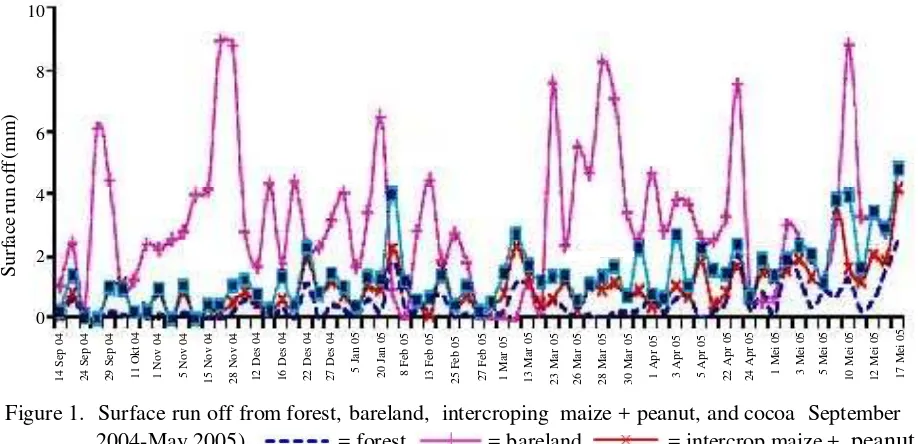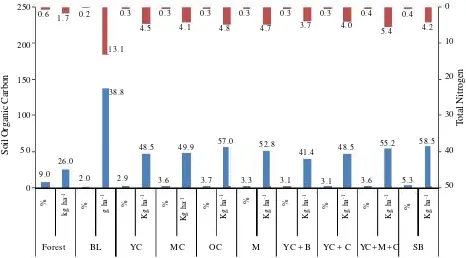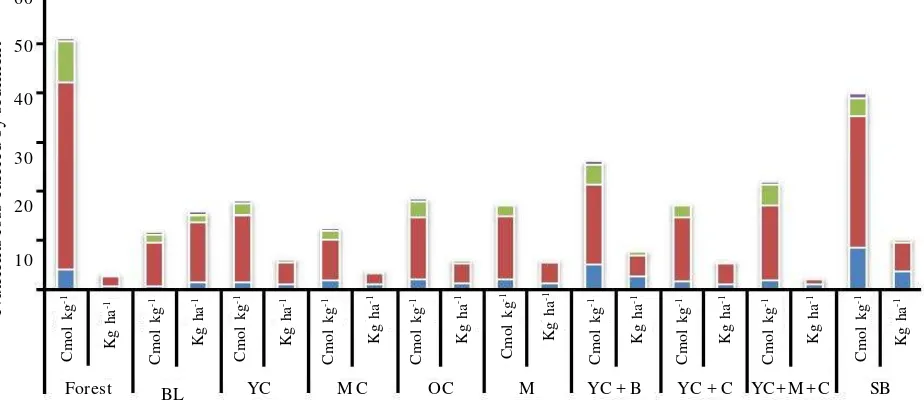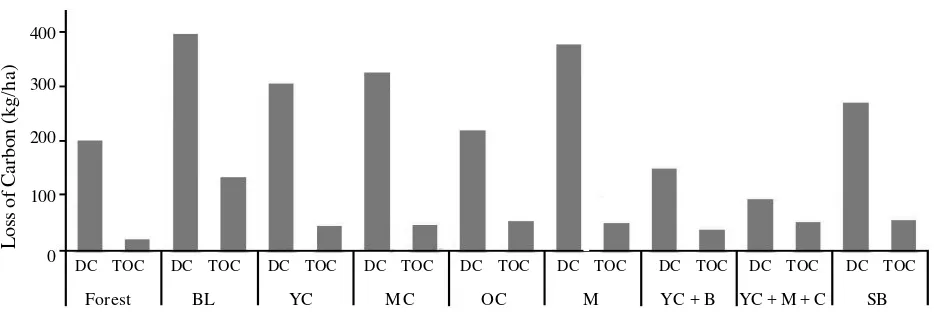J Trop Soils, Vol. 17, No. 3, 2012: 259-266
Characterization of Surface Runoff, Soil Erosion and Nutrient Loss
on Forest-Agriculture Landscape
Yayat Hidayat*, Kukuh Murtilaksono and Naik Sinukaban
Soil Science and Land Resources Department, Faculty of Agriculture, Bogor Agricultural University, Bogor, Indonesia. *Coresponding author, e-mail: [email protected]
Received 20 November 2011/ accepted 6 September 2012
ABSTRACT
The study was aimed to quantify volume of surface runoff, soil erosion and nutrient loss from the forest-agriculture landscape (forest margins) in Lore Lindu National Park Central Sulawesi. Surface runoff volume and soil erosion were measured daily on erosion plots. It was installed on several land use types i.e. forest land, maize, young cocoa, medium cocoa, old cocoa, vanilla, shrub and bush and bareland, on the soil Typic Dystrudepts with slope ± 40%. The nutrient content in surface runoff and sediments were analyzed from selected surface runoff and sediment samples. Surface runoff and soil erosion from agriculture land were respectively 2.1 to 3.4 and 3.6 to 5.8 times higher than from forest lands. Meanwhile, surface runoff and soil erosion from bareland were respectively 7.0 and 23.7 times greater than forest land respectively. Sediment nutrient contents from forest land were higher than agriculture land. In the contrary, total nutrient lost from agriculture land were higher than forest land ones. Nutrient losses carried by surface runoff were larger than those losses carried by sediments. Dissolved organic carbon (DOC) loss in surface runoff was 6,1 to 8,0 times higher than total organic carbon (TOC) loss in sediments. Likewise, nitrate (NO3-) loss in surface runoff was 1.9 to 12.1 times higher than total nitrogen (TN) in sediments as well as potassium,
calcium, magnesium and sodium losses. Potassium is dominant cation loss carried by the surface runoff, while calcium is mainly carried by sediment.
J Trop Soils, Vol. 17, No. 3, 2012: 259-266
ISSN 0852-257X
INTRODUCTION
DOI: 10.5400/jts.2012.17.3.259
Keywords: Dissolve organic carbon, forest-agriculture landscape, nutrient loss, soil erosion, surface runoff
Nutrients loss due to surface runoff and soil erosion carried away from agriculture land is the main cause of soil degradation of agriculture land, particularly on conventionally land management
(Bertol et al. 2003) and steep slope. Nitrogen,
phosphorus, organic carbon, potassium, calcium, magnesium and sodium are the main nutrients loss carried by overland flow and soil erosion (Mello
2002 cited by Bertol et al. 2003).
Loss of nutrients can be expressed in terms of nutrient concentrations in surface runoff and transported sediment, or total nutrients loss carried by surface runoff and soil erosion per unit of time (days, seasonal or annual rain). The amount of nutrient loss is influenced by soil type and soil fertility, type fertilizer and application methods, crop canopy cover, slope, and rainfall volume and intensity
(Gascho et al. 1998), as well as soil and crop
managements (Barisas et al. 1978).
Conventional land management is usually conducted by clearing weeds and litter of plants, hoeing and smoothing the soils, so that conventionally cultivated lands are characterized by clean, flat and smooth of soil surfaces. Conservation tillage is distinguished by conventional tillage due to presence of litter and crop residues in the soil surface and higher of surface roughness. Therefore the rate of surface runoff and soil erosion can be reduced, and nutrients loss will be lower in conservation tillage
systems (King et al. 1996).
Loss of nutrients are expected to be reduced by tillage systems and crop management that retain crop residues on soil surface. But, crop residues
and decomposed litters can be flush (Burwell et al.
1975) and dissolved nutrients can be carried away
by surface runoff and soil erosion (Barisas et al.
1978; Johnson et al. 1979). Similarly most of the
nutrients (especially potassium) that resulted from burned crop residues and other vegetations on cultivation system will disappear and is carried by surface runoff and soil erosion.
the forest–agriculture landscape of Lore Lindu National Park, Central Sulawesi.
MATERIALS AND METHODS
Study Site
Descriptive field research (non-experimental design) was conducted to measure surface runoff volume, soil erosion and nutrient loss from several land use types, which were located on an agriculture-forest landscape of Lore Lindu National Park. Administratively research sites was located in Bulili village, Palolo Subdistrict, Central Sulawesi.
Data Collected
Surface runoff and soil erosion were measured daily volume of surface runoff and amount of eroded soil were collected in the tank at down end of erosion plot. The erosion plots were constructed on a 40% slope and several landuse types namely forest, maize, maize + peanut, young cocoa, medium cocoa, old cocoa, young cocoa + banana, young cocoa + maize + cassava, vanilla, shrub and bush, reed
(Imperata Cylindrica), and bareland. The content
of nutrients that were carried by surface runoff and soil erosion were analyzed from selected surface runoff and sediment samples that were collected from July 2004 to May 2005.
Soil Analysis
Analysis of soil physical properties were conducted in the laboratory of Department of Soil Science and Land Resources, Bogor Agricultural University, while soil and sediment chemical characteristics (organic carbon, total nitrogen, exchangeable of calcium (Ca), potasium (K), magnesium (Mg) and sodium (Na)), nutrients
content in surface runoff (NO3-, dissolve organic
and inorganic carbons, calsium (Ca), potasium (K), magnecium (Mg) and sodium (Na)) were analyzed in the Laboratory of STORMA-UNTAD, Faculty
Table 1. Types of analysis and method for the soil, sediment, and surface runoff analysis.
Type of Analysis Type of Sample Analysis Method
Organic carbon Soil, Sediment Walkley-Black (dichromate), titration Total nitrogen Soil, Sediment Micro-Kjeldahl, titration Exchangeable Ca, Mg, K, and Na Soil, Sediment NH4OAc pH 7, AAS
N(NO3-) Surface runoff CFA (continous flow analysis)
DIC (dissolve inorganiccarbon) DOC (dissolveorganic carbon)
Surface runoff Surface runoff
CFA CFA
Ca, Mg, K, Na Surface runoff ICP
of Agriculture, University of Tadulako. Types and methods of analysis are presented in Table 1.
Data Analysis
Data were analysed descriptively by comparing measured data between land use types. Statistically, a pairwise comparison test (Sudjana 1992) was used to identify significant level of daily data of surface runoff volume and soil erosion.
RESULTS AND DISCUSSION
Surface Runoff and Soil Erosion
Surface runoff and soil erosion from agriculture land were higher than forest land. Surface runoff from young cocoa, medium cocoa, old cocoa, maize, maize + bean, young cocoa + banana, young cocoa + cassava, cocoa + maize + cassava, shrubs and
bush, and reeds (Imperata cylindrica) were 2.1 to
3.4 times greater than the surface runoff from forest lands. While surface runoff volume of bareland could reach 7 times greater than forest land. Soil erosion from agriculture land and bareland were 3.6 to 5.8 and 23.7 times higher than forest land, respectively (Table 2). The results of pairwise comparison test (n= 72, á= 0.1) showed that daily surface runoff volume and soil erosion were significantly different between land use types. Daily surface runoff volume and soil erosion on young cocoa were significantly different than medium cocoa, even though values of accumulated data from September 2004 to May 2005 seemed hardly different.
Landuses Surface runoff Soil erosion
Table 2. Surface runoff and soil erosion from agriculture and forest lands on Typic Eutrudepts, slope
40% and rainfall 1,696 mm (Hidayat et al. 2010).
*CtNF: Compared to natural forest (factor higher).
Figure 1. Surface run off from forest, bareland, intercroping maize + peanut, and cocoa September
2004-May 2005). = forest, = bareland, = intercrop maize +
peanut,
and
= cocoa.
(28.5%) (Hidayat 2009). Infiltration rate of forest land that was classified as moderate-very fast (7.50
- 40.26 cm hr-1) was higher than on agriculture land
(0.75 to 17.96 cm hr-1(young cacao), 1.02 - 2.05 cm
hr-1 (medium cocoa), 0.015-3.00 cm hr-1 (old cocoa),
and 4.44 to 9.00 cm hr-1 (maize + peanut)) (Hidayat
et al. 2008). Performance of surface runoff in
several rain days is presented in Figure 1 and 2. Ground clearing and tillage activities at the time of planting agriculture crops as well as weeding and maintenance activities of plant s (bunding surrounding plant stands) were the major cause of high soil erosion on intercropping maize + peanut, maize, and intercropping young cocoa maize +
cassava. It was consistent with the research result of Roose (1986) who showed that clearing of forests (clear felling system) led to increase soil erosion by more than 10-folds.
Nutrient Loss in Transported Sediments
Soil Organic Carbon and Total Nitrogen
Soil organic carbon in transported sediment from forest land was 1.7 - 4.4 times higher than from agriculture land ones. However, the amount of soil organic carbon lost from agriculture land was higher (1.6 to 5.3 times) than forest land. The same pattern was also observed in total nitrogen, where
Figure 2. Surface run off from young, medium and old cocoas (September 2004-May 2005). =
young cocoa, = medium cocoa, and = old cocoa.
Figure 3. Soil organic carbon and total nitrogen losses carried by sediment from forest land (Forest), bareland (BL), young cocoa (YC), medium cocoa (MC), old cocoa (OC), maize (M), young cocoa + banana (YC + B), young cocoa+cassava (YC + C), young cocoa + maize + cassava (YC + M + C), and shrub and bush (SB).
total nitrogen levels in sediment from forest land was 1.6 to 3.1 higher than agriculture land. Conversely, the total loss of nitrogen from agriculture land was 2.1 to 7.5 times higher than forest land (Figure 3).
The high levels of soil organic carbon and total nitrogen in the sediment of forest land were due to it’s fine texture sediment (clay) and the large amount of litter and other organic materials that had been decomposed in forest floor. Conversely sediment
derived from bareland was more coarse-textured (sand) and it had low level of organic matter and other nutrients. Although the levels of organic carbon was high, the amount of soil organic carbon and total nitrogen lost from forest land were much lower than the agriculture and bareland. Loss of total soil
organic carbon from forest land was 26.4 kg ha-1
Potassium, Calcium, Magnesium and Sodium
Potassium, calcium, magnesium and sodium contents in transported sediments from forest land
wer e 3. 91, 38. 8, 8. 47, a nd 0. 8 cmol kg- 1
respectively that were much higher than those
contents in the bareland, i.e. 0.54, 8.97, 1.64 and
0.57 cmol kg-1. Tota l pot assium, calcium,
magnesium and sodium lost by soil erosion from bareland respectively 1.44, 12.26, 1.36, and 0.89
kg ha-1 were higher than total nutrients losses
from forest land that were 0.44, 2.22, 0.30, and
0.04 kg ha-1. In other words, converting of forest
land into bareland caused increasing loss of potassium, calcium, magnesium and sodium respectively 326.2, 552.6, 457.3, and 2303.4%.
The same pattern was noted for agriculture lands (Figure 4).
Selectivity of soil erosion which mostly transported fine soil particles and colloidal size of organic matter (lighter) caused nutrient content in transforted sediments were higher than in the origin soil (top soil). The increase of nutrients content in sediment were highest on forest land but lowest on bareland. Soil organic carbon in transported sediment from forest land (9.02%) increased 2.8 times compared to the soil organic carbon of topsoil (0-10
cm), i.e. 3.23%. Total nitrogen and potassium also
increased by 2.1 and 2.5 times. The increasing of nutrient contents in transported sediments occurred in bareland, young cocoa, medium cocoa, maize, young cocoa + maize + cassava (Figure 5).
Figure 4. Potassium, calsium, magnesium and sodium loss carried by sediment from forest land (Forest), bareland (BL), young cocoa (YC), medium cocoa (MC), old cocoa (OC), maize (M), young cocoa + banana (YC + B), young cocoa+cassava (YC + C), young cocoa + maize + cassava (YC + M + C), and shrub and bush (SB).
Figure 5. Soil organic carbon (%C), total nitrogen (%N), and potassium (cmol kg-1 K) in topsoil (0-10
cm) and sediments from forest land (Forest), bareland (BL), young cocoa (YC), medium cocoa (MC), maize (M), and intercropping young cocoa+maize+cassava (YC + M + C).
Nutrients Loss in Surface Runoff
Dissolved Carbon
Surface runoff that flows above soil surface transports dissolved nutrients which in turn lead to nutrient loss from the soil (especially agriculture land). Dissloved nutrients then enter into the water bodies and cause nutrients enrichment of the water system (eutrophication). Dissolved organic carbon (DOC) is a major loss of carbon compounds carried by the flow of surface runoff. Compared to dissolved inorganic carbon (DIC), the proportion of DOC was average 74%, while the DIC is about 26% (Figure 6). The highest DOC concentrations
was found in forest lands, i.e. 57.12 mg l-1, and the
lowest (0.10 mg l-1) was in intercropping young
cocoa + maize + peanut. Moore et al. (2008)
showed DOC concentrations of leachate from
Figure 6. Dissolved inorganic carbons ( ), dissolved organic carbons ( ), and total dissolved carbons
( ) in surface runoff on forest land (Forest), bareland (BL), young cocoa (YC), medium cocoa (MC), old cocoa (OC), maize (M), young cocoa + banana (YC + B), young cocoa + maize + cassava (YC + M + C), and shrubs and bush (SB).
incubated soil (forest soil and peat soil) ranged from
less than 2 mg l-1 to more than 50 mg l-1.
Loss of carbon carried by flow of surface runoff (DC) was higher than its loss by transported sediment (TOC, t otal soil organic ca rbon). Comparison of DC to TOC were 6.1 times on the maize and 8.0 times on forest land (Figure 7).
Nitrate (NO3-)
Nitrate is a major loss of nitrogen compound transported by surface runoff. Loss of nitrate from agriculture land was 2.0 to 14.2 times higher than forest land. The highest nitrate loss was obtained on intercoping of young cocoa + cassava + maize
(YC + M + C), i.e. 65.7 kg ha-1. Loss of nitrogen
transported by surface runoff (NO3-) was 1.9 to
12.1 times higher than its loss carried by sediments (total nitrogen/TN) (Figure 8).
Potassium, Calcium, Magnesium and Sodium
Potassium is the main base cation loss carried by flow of surface runoff. The highest potassium
loss was 255.5 kg ha-1 namely in intercropping
young cocoa + maize + cassava, but the lowest
was 12.6 kg ha-1 on the forest land (Figure 9).
Potassium content in top soil was relatively high that resulted from burned materials (wood, shrub, plant litter, and other organic materials above ground surface). Potassium is easily carried by surface runoff because its bound on soil particle mor e wea kly compa r ed t o ca lcium a nd
Surface runoff and soil erosion from agriculture land were higher than forest land. Low rainfall interception due to low plant canopy cover and low infiltration rate were the major cause of high surface runoff and soil erosion on agriculture land. Concentrations of nutrients lost were inversely proportional to the surface runoff and soil erosion volume.
Nutrients content on transported sediment from forest land were higher than agriculture land, but total nutrients loss from forest land were farly less than agriculture land.
Nutrients loss carried by flow of surface runoff were higher than transported sediments ie. carbon, nitrogen, potassium, calcium, magnecium, and
sodium
.
300
200
100
0
Figure 8. Loss of nitrogen carried by surface runoff (NO3-) and transforted by sediment (TN) from forest
land (Forest), bareland (BL), young cocoa (YC), medium cocoa (MC), old cocoa (OC), maize (M), young cocoa+banana (YC + B), young cocoa+maize+cassava (YC + M + C) and shrub and bush (SB).
ACKNOWLEDGEMENTS
Thanks go to the STORMA (stability for rain forest margin) Project especially to Prof. Gerhard Gerold as chairman of the Sub Project B2 who has provided financial assistance, field research facility and laboratory analysis.
REFERENCES
Barisas SG, JL Baker, HP Johnson and JM Laflen. 1978. Effect of tillage systems on runoff losses of nutrients, a rainfall simulation study. T Am Soc Agric Eng 21: 893-897.
Bertol I, EL Mello, JC Guadagnin, ALV Zaparolli, and MR Carrafa. 2003. Nutrient Losses by Water Erosion. Sci Agric 60: 581-586.
Burwell RE, DR Timons and RF Holt. 1975. Nutrient transfort in surface runoff as influenced by soil cover and seasonal periods. Soil Sci Soc Am Proc
39: 523-528.
Gascho GJ, RD Wauchope, JG Davis, CC Truman, CC Dowler, JE Hook, HR Sumner and AW Johnson. 1998. Nitrate-nitrogen, soluble, and bioavailable phosphorus runoff from simulated rainfall after fertilizer application.
Soil Sci Soc Am J 62: 1711-1718.
Hidayat Y, N Sinukaban, H Pawitan and SD Tarigan. 2008. Dampak perambah an hutan terhadap aliran permukaan dan erosi di DAS Nopu Hulu, Sulawesi Tengah. J Trop Soils 13: 59-65 (in Indonesian).
Hidayat Y. 2009. Modifikasi factor tanaman dalam m o d e l A N S W E R S . [ D i s e r t a s i ] S e k o l a h P a s c a s a r j a n a I P B . B o g o r . 1 6 9 p . ( i n In don esian )
Hidayat Y, N Sinukaban, P Hidayat and K Murtilaksono. 2010. Modifikasi faktor tanaman dalam model ANSWERS untuk memprediksi erosi di daerah tropika basah (Studi kasus DAS Nopu Hulu, Sulawesi Tengah). J Tanah Iklim 32: 43-53 (in Indonesian).
Johnson AH, JL Baker, WD Shrader and JM Laflen. 1979. Tillage system effect on sediment and nutrients in runoff from small watersheds. T Am Soc Agric Eng 22: 1110-1114.
King KW, CW Richardson and JR Willians. 1996. Simulation of sediment and nitrate loss on a vertissol with conservation practices. T Am Soc Agric Eng 39: 2139-2145.
Moore TT, D Pare and R Boutin. 2008. Production of dissolved organic carbon in Canadian Forest Soil.
Ecosystems 11: 740-751.
Roose EJ. 1986. Runoff and erosion before and after clearing depending on the type of crop in western Africa. In: R Lal, PA Sanchez and RW Cummings Jr (eds). Land Clearing and Development in the Tropics. AABalkema/Rotterdam/Boston, pp. 317-330.





